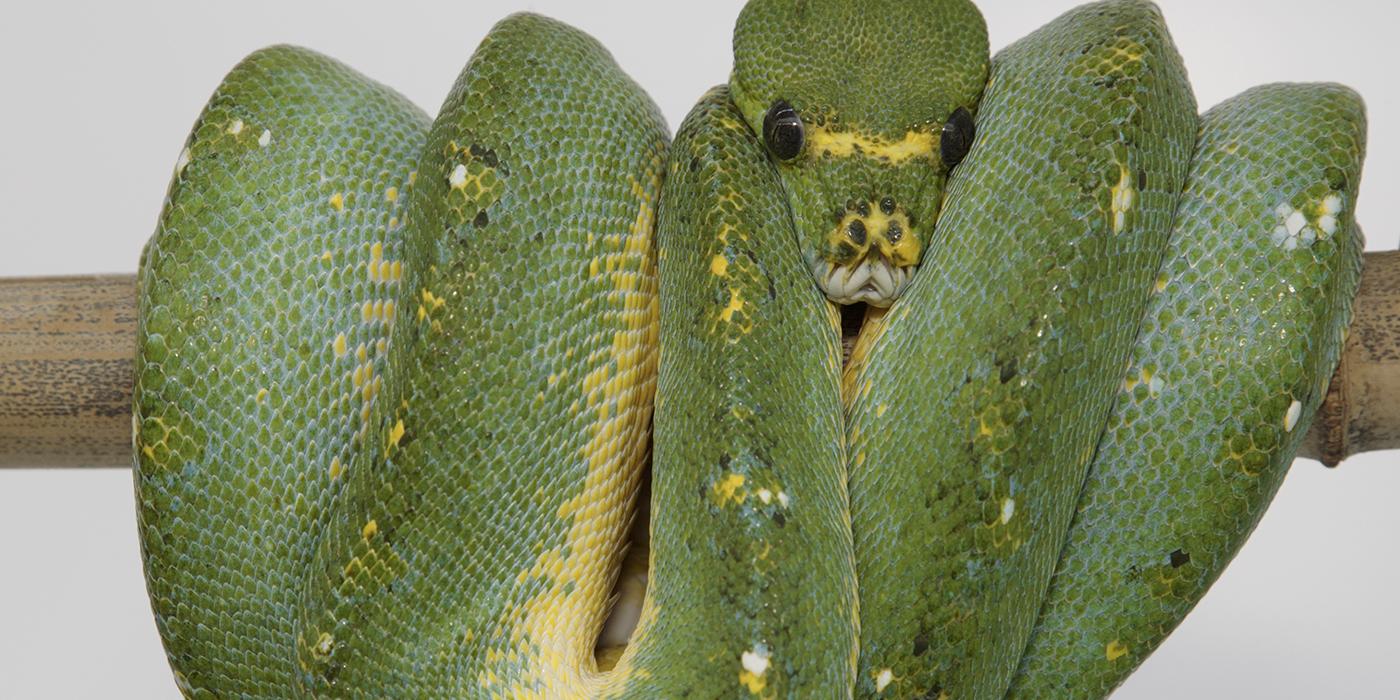Green tree pythons are named for their vibrant green color. These nonvenomous snakes and found in the tropical rainforests of New Guinea, eastern Indonesia, and the northeast Cape York Peninsula of Australia.
Physical Description
Green tree pythons have diamond shaped heads with irregular scales and are named for their vibrant green color. They have a white or yellow vertebral stripes and many also have yellow, green or blue spots. Juveniles are born bright yellow, red or red-brown, and do not get their characteristic green color until they are 6 to 12 months old.
Their coloration helps them to camouflage and avoid predators. A juvenile's yellow color blends into the edges of the rainforest. Their brick red coloration helps them blend in with the forest floor or tree branches. The bright green of adults helps them hide among the leaves of tall trees.
A prehensile tail helps the green tree python climb and catch prey. These snakes rest coiled up, hanging horizontally on branches. They dangle their tails to lure curious prey, and then hold onto the branch with their tail when they strike.
Size
Green tree pythons can reach lengths of about 5 feet (1.5 meters).
Native Habitat
Green tree pythons are found in New Guinea, eastern Indonesia, and the northeast Cape York Peninsula of Australia.
They prefer tropical rainforests with thick vegetation and high humidity. They may also inhabit secondary forests and gardens. Most of their time is spent in trees, but they also come down onto the ground, especially at night.
Lifespan
The green tree python's lifespan in the wild is believed to be an average of 15 years. However, they can live up to 20 years in human care.
Food/Eating Habits
Green tree pythons eat mostly small mammals and reptiles. As juveniles, they are diurnal (or active during the day) and hunt smaller animals. As adults, they are nocturnal and hunt larger prey that is more active at night.
These pythons locate prey by sight and use labial pits to identify an animal's heat signature. They may also wiggle their tail like a lure. When curious prey gets close enough, they strike.
At the Smithsonian's National Zoo, green tree pythons are fed mice and rats.
Reproduction and Development
These snakes generally reach sexual maturity at about 2 years old. Both males and females mate with several different partners in their lifetime. They do not have a specific breeding season and may mate at any time of the year.
Females do not eat during gestation, which lasts 70-90 days, and spend time looking for a suitable nest site. They prefer holes in hollow trees but will nest in any protected area with enough humidity. Females can produce a clutch of 5-35 eggs. They regulate the incubation temperature by wrapping around their eggs and using “muscular shivers” to produce heat. The optimal incubation temperature is 85 degrees Fahrenheit (29.5 degrees Celsius). Females protect and incubate their eggs for 45-56 days until they hatch.
Conservation Efforts
Green tree pythons are threatened by habitat loss due to logging in rainforests, especially in western New Guinea. The need for genetic variation puts a strain on the wild population. These are also very popular in the international pet trade, due to their vibrant color, and there is a small market for their meat and skin.
Protection under CITES Appendix II should help decrease the number of green tree pythons exported for trade. Australia has national laws restricting the collection of green tree pythons and banning their importation from New Guinea. Captive breeding programs could also help meet the demand for pets without decreasing the wild population.
Help this Species
- Practice ecotourism by being an advocate for the environment when you’re on vacation. During your travels, support, visit or volunteer with organizations that protect wildlife. Shop smart too! Avoid buying products made from animals, which could support poaching and the illegal wildlife trade.
- Choose your pets wisely, and do your research before bringing an animal home. Exotic animals don’t always make great pets. Many require special care and live for a long time. Tropical reptiles and small mammals are often traded internationally and may be victims of the illegal pet trade. Never release animals that have been kept as pets into the wild.
- Share the story of this animal with others. Simply raising awareness about this species can contribute to its overall protection.
Animal News

Leaf-tailed Gecko Treated for Skin Cancer With Chemotherapy





